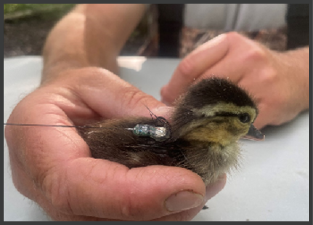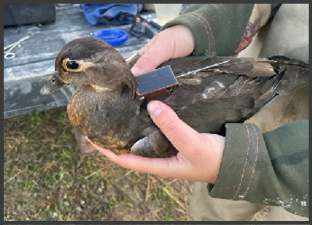Unboxing Delmarva Breeding Wood Ducks
The DNREC Division of Fish and Wildlife is partnering with the University of Delaware’s Waterfowl and Upland Gamebird Center, Delta Waterfowl, Maryland DNR, Delaware Wild Lands Inc., Delaware Audubon Society, and Nemours Wildlife Foundation to study wood duck nesting and brood ecology in the Delmarva Peninsula. Under the mentorship of Dr. Chris Williams, graduate student Blake Struthers is researching what cues wood duck hens use to select nest boxes and how box characteristics affect nest success, identifying areas and habitats that hens prefer to use while raising their broods, and establishing a baseline expected survival rate of ducklings throughout this region.
“This information will help to establish recommendations for optimal nest box placement and inform better habitat management practices on the Delmarva that we can use to boost nest success and increase duckling survival to provide more birds for fall hunting seasons and subsequent breeding seasons,” Williams said.
To determine the best placement strategy for nest boxes, Struthers is analyzing how 20 different box characteristics and habitat attributes influence nest box use, nest parasitism (when hens lay eggs in nests that are not their own), and nest success. The data collected from 2020-2023 includes information from over 300 nest boxes and 650 individual nests at seven sites throughout the Delmarva Peninsula including four DNREC Wildlife Areas and Conservation Areas. This large sample is representative of many of the various habitats suitable for wood ducks in the Delmarva and Mid-Atlantic region and will be applicable for anyone interested in initiating or improving existing wood duck nest box programs.
Struthers is also interested in learning more about the life of ducklings after they leave the nest box. To investigate this, he is using GPS and radio transmitters attached to hens and their ducklings during the 2023 and 2024 nesting seasons to collect fine-scale movement, habitat use, and survival data. Hens are fitted with a solar-powered GPS unit strapped on like a backpack. These units are programmed to log GPS points of the hen’s location every hour.
“Ducklings remain very close to their mothers during their first month of life, so the hen GPS locations accurately reflect the areas she brings her brood to forage and hide from predators. Once a brood moves on from a small wetland or section of a stream, we navigate to the coordinates of the locations we obtained from the hen transmitters to conduct vegetation surveys and other habitat measurements”, Struthers said. “This gives us very detailed knowledge about the areas that hens seek out to raise their broods successfully.”
In addition to the transmitters on the hens, the ducklings are also fitted with a jellybean sized radio transmitter weighing less than 1g. These tiny transmitters allow Struthers to monitor and track individual duckling survival as well as identify major predators and other causes of mortality. During the two breeding seasons, Struthers is planning to deploy 80 GPS transmitters on hens and 240 radio transmitters on ducklings throughout the Delmarva Peninsula.
“Even though the project is ongoing, we have still been able to generate very informative preliminary results from data already collected” Struthers said, “Our early analysis indicates that keeping boxes adequately spaced so they are not visible from neighboring boxes or even placed in separate wetlands is important”. Struthers explained that when boxes are densely congregated, hens often engage in “dump nesting” where multiple hens will lay in the same box until it accumulates dozens of eggs. If this happens, nests may not be incubated successfully, and this often results in nest abandonment. Predators also benefit from clumped nest boxes since they can find more nests and destroy them faster if they are all close together.
Struthers has also found that boxes placed over water seem to be used more often and have a higher success rate than those placed on land. Boxes situated in deeper water in larger, more expansive wetlands are used and hatch nests at an even higher rate.
“We do emphasize, however, that keeping boxes maintained is the single most important aspect of a nest box program” Williams mentioned. “If they are placed in a location that is difficult or time consuming to access, managers and landowners are much less likely to check on them regularly”. The biologists noted that wood ducks do not bring in their own nesting material, so landowners must place wood shavings in boxes for them prior to each nesting season. Boxes also degrade over time, and typically have a lifespan of 10-25 years depending on the wood used to construct them. Maintaining structurally sound boxes that protect hens and ducklings by keeping out wind and rain is also critical, and this requires occasional replacement of boxes as they age. Williams further mentioned, “We recommend groups or individuals with nest box programs keep this in mind when choosing locations for nest boxes and follow the above recommendations only to the degree that boxes remain regularly accessible. For example, although we found higher success rates from boxes in open water, they should not be placed there if it will be too difficult to get to them. Rather, a box adjacent to water that is regularly checked and maintained would be a better choice.”
Struthers also explained that it is important to consider where a brood will go when choosing where to place boxes. Hens will lead their ducklings as far as necessary to reach high quality brood rearing habitat. “Our data from 2023 indicates that these are areas with many small wetlands close together or large impoundments that have abundant emergent vegetation that enable ducklings to avoid predators,” Struthers said. “However, traveling from one area to another exposes ducklings to predators and exhaustion along the way. We found that broods traveling shorter distances from the nest box to brood habitat experience greater survival rates.”
Placing boxes within or near areas of quality brood rearing habitat will help to increase survival of ducklings after they’ve left the box. Keeping these guidelines in mind will help land managers, hunting groups, and individuals have more successful wood duck nest box programs and hatch more ducks that can be enjoyed by hunters, birdwatchers, and other wildlife enthusiasts.

A radio transmitter attached to a wood duck duckling.

A solar-powered GPS unit affixed to a wood duck hen.
_and_Kursha_Baier_(right,_Wood_Duck_Technician)_with_a_brood_of_wood_ducks.png)
Blake Struthers (left, Graduate Research Assistant) and Kursha Baier (right, Wood Duck Technician) with a brood of wood ducks.

